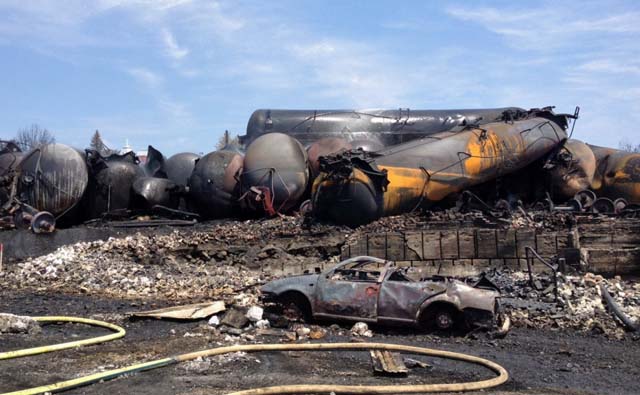The aftermath at Lake Megantic - Date/Photographer unknown. 4 April 2014 Railway's One-Man Crew Documents
Kept Secret Ottawa Ontario - One year before the Lake Megantic train disaster, Montreal Maine & Atlantic Railway (MMA) began running trains steered by a sole engineer to the small town, a bare-bones staffing arrangement that began after Transport Canada approved the safety measures the company had in place.
MMA had to provide two documents to the regulator: a risk assessment, covering a range of hazards to be mitigated, and an implementation plan, detailing the practices and technologies in place to make the reduced staffing safe.
But these documents are considered to be "third party" by Transport Canada, meaning the regulator will not release them to the public, despite the fact they contain MMA's public safety commitments.
The secrecy leaves Canadians in the dark about their security, say public safety advocates.
"In effect, Transport Canada is accepting a higher level of risk to the public so the operator can reduce their costs. This is a fairly important trade-off and it needs to be made in an open and transparent manner," said Mark Winfield, a York University associate professor who researches public safety regulation.
"The public has a right to know about, and to question, these arrangements."
After Transport Canada referred the Star to MMA for the documents, company chairman Edward Burkhardt declined to provide them.
"The information you are requesting is right in the middle of dozens of lawsuits, and in these circumstances we agree with Transport Canada's decision to not provide it," Burkhardt said in an email.
A spokesperson with Canada's rail industry association said one of the documents, the risk assessment, "delves into the unique nature of a railway's operations and touches on sensitive and competitive information."
"As such, the information is treated accordingly," said Paul Goyette, with the Railway Association of Canada.
On 6 Jul 2013, a 72-car train carrying volatile Bakken crude plowed into downtown Lake Megantic, killing 47 people and destroying a swath of the downtown.
The unmanned train derailed and exploded after rolling down a steep incline from nearby Nantes, where it had been parked by sole crew member Tom Harding.
Two weeks after the derailment, Transport Canada outlawed one-man crews on trains carrying dangerous goods.
The Transportation Safety Board, meanwhile, is investigating whether the reduced staffing was a factor in the accident.
Three days after the disaster, Luc Bourdon, director general of rail safety at Transport Canada, said MMA began using one-man crews on the 200-kilometre rail corridor between Farnham, Quebec, and Lake Megantic in 2012.
Before that, the rail company "had to meet with Transport Canada and demonstrate to us that they could do it safely," Bourdon told a 9 Jul 2013 news conference.
The Star, as well as the public advocacy groups Canadian Centre for Policy Alternatives, and Canadians for Accountability, subsequently filed individual requests under Canada's Access to Information legislation for details of the reduced staffing approval.
After initially indicating the department would require an extension of 365 days to provide that documentation, the regulator recently told the Star and others that there was no record of the approval because it "does not grant permissions and/or authority to operate single-person train operations."
When asked for clarification, Transport Canada said MMA "informed Transport Canada of its intention to use one-man crews."
The regulator then met with MMA, which "demonstrated that its use of one-man crews would meet the safety standards in place."
"It's important to understand that this is not a permission-granting exercise," wrote Transport Canada spokesperson Brooke Williams.
Burkhardt, however, told the Star that the suggestion there were no documents was "hard to reconcile with fact."
He said the regulator "did approve" one-man crews, and that there were "voluminous exchanges of messages with Transport Canada, including operating regulations.
"I think Transport Canada is hung up on semantics, i.e. the difference between "approved" and "didn't disapprove" after MMA complied with requirements they provided," Burkhardt said.
He declined to send the Star documents containing Transport Canada's written approval, again citing ongoing litigation.
Burkhardt added the entire issue is a "red herring," saying the one-man crew had nothing to do with the derailment.
E. Wayne Benedict, a long-time rail employee who is now a Calgary-based labour lawyer, said Transport Canada can technically say it did not "allow" the use of one-man crews because of the setup of the rail regulation regime, which uses what's called safety management systems (SMS).
The SMS regime puts the responsibility on individual rail companies for the safety of their day-to-day operations.
Transport Canada then takes on an oversight role, auditing the systems for compliance.
As the Star previously revealed, a rail company's SMS, detailing training, practices, and safety policies, is considered a third-party document, which means the public cannot access it.
"This goes back to the fundamental problem with the railway safety regulatory regime," Benedict said, because it allows companies to set their own safety rules, which they can then claim is proprietary information.
"The whole system is, in my opinion, pretty flawed," he said.
Wendy Gillis.    |

